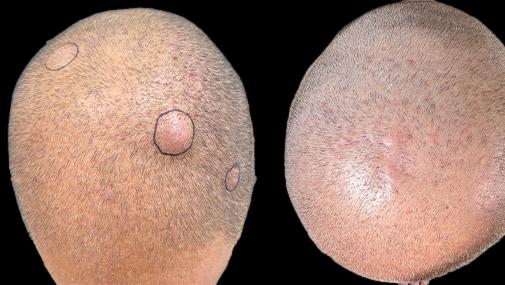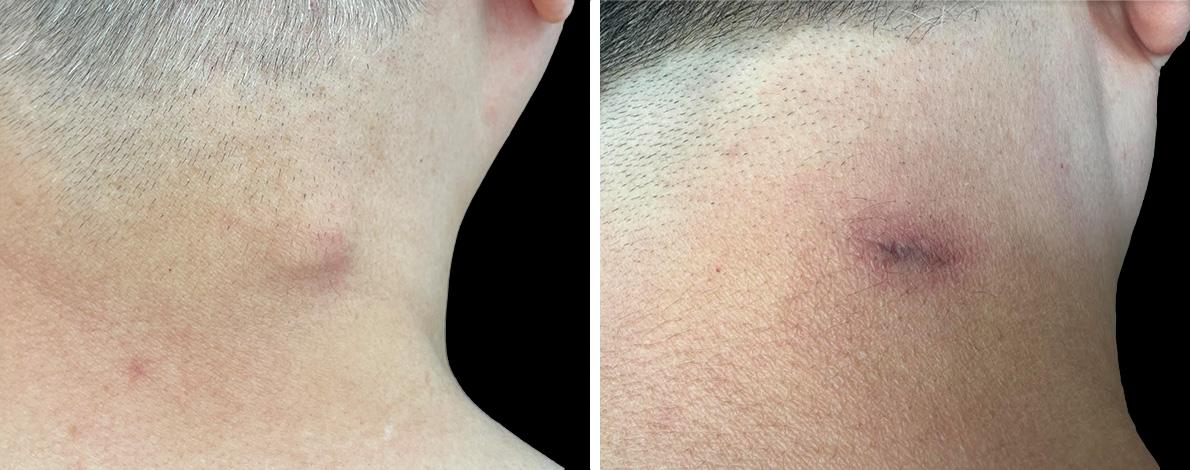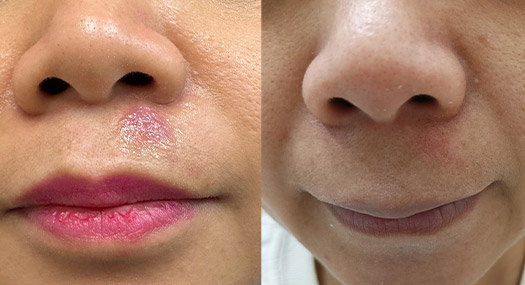Cysts are extremely common and can vary dramatically from very small to very large, often feeling like a little bump or knot under the skin. They usually start as a small lump and can grow with time.
Common Types of Cysts
There are many different types of cysts but three common types of cysts in the skin include Epidermoid Inclusion Cysts, Pilar Cysts, and Digital Mucous Cysts, and each are unique. Different types of cysts occur in different parts of the body for different reasons, so it’s important to have a general understanding of cysts. If you notice one developing, have it checked by a board-certified Dermatologist.
Before & Afters
This lovely patient had 3 large pilar cysts on their scalp which had been present for several years but were problematic when shaving. Dr. Roller excised the cysts and closed the skin with dissolving sutures.
Our patient’s cyst had fluctuated over the years and had been treated with antibiotics and drainage. It was excised by Dr Roller and closed with dissolving sutures. Photo taken 3 months after removal.
This patient had a sebaceous cyst for approximately 2 years which had repeatedly flared up and been treated with antibiotics and drainage, however, she wished the cyst to be removed. Dr Roller excised the cyst and closed with dissolving sutures.
Epidermoid Inclusion Cysts
Made common type of cyst in the skin made famous in “pimple-popping videos”, these cysts return repeatedly after you squeeze them. They most commonly occur on the face and upper body. Epidermoid inclusion cysts can form on their own or when a hair follicle becomes disrupted/clogged and creates a pocket that traps skin cells that would normally be sloughed off (keratin).
Epidermoid inclusion cysts are benign and usually do not cause any discomfort. They sometimes can become inflamed or infected in which case the cyst becomes suddenly more swollen, painful and red.
Many people find epidermoid inclusion cysts bothersome or not aesthetically pleasing and wish to have them removed. This can be performed in a simple in-office excision with local anesthetic, with minimal to no downtime. These cysts should only be removed when they are not inflamed/infected.
Pilar Cysts
Pilar cysts (sometimes known as trichilemmal cysts) are skin-coloured bumps that appear on your scalp and can feel like a knot under your hair. It is a keratin-filled cyst, that occurs when the hair follicle gets clogged. While generally not harmful, pilar cysts can be irritating and cause pain when brushing hair.
Pilar cysts can be completely removed with a simple in-office surgical excision so that they do not return again.
Techniques used for Cyst removal
Cryotherapy
The cyst is drained and then liquid nitrogen is used to alternately freeze and thaw the cyst.
Steroid injection
The cyst is injected with intralesional corticosteroid.
Surgical Excision
The cyst is completely removed surgically and the skin is sutured closed.
Frequently Asked Questions
What causes a cyst?
Epidermal inclusion cysts form after a blockage to a hair follicle. Skin cells are naturally shed by your body as the cells start to die. This shedding process can be disturbed if you have a skin condition such as acne, persistent sun damage, surgical wounds, or scratches. This causes these cells and other substances, such as keratin, to become trapped and accumulate under the skins surface. Epidermal inclusion cysts are the most common type of skin cyst. They form from either a blockage of the hair follicle, or after a trauma - even something as small as a bad scratch, where the outer skin cells get trapped under the skin! Our skin cells naturally shed off our bodies, and if they are caught under the skin a cyst can form. The cells and keratin fill the contents of the cyst. The cyst will feel like a small round bump under the skin, can have a tiny blackhead plugging the central opening and sometimes a thick, smelly cheesy substance can leak from the cyst.
These cysts are harmless, slow growing, of often painless. Many patient seek our surgical removal because they do not like the cyst looks or if it is in a location that is bothersome.
Do cysts go away?
Cysts can have a pattern of becoming inflamed and then settling. If an inflamed cyst then disappears there is a strong chance that it will come back again. The skin cells that are typically shed from the body are enclosed in a wall, called a sac. Keratin, the main ingredient in cyst pus, is produced by the sac. Even if your cyst bursts and drains, unless the sac is removed it could come back again. It is not certain that a cyst will reappear, but there is still a chance. A simple in-office surgery called cyst wall removal typically prevents the cyst from returning.
Are cysts caused by stress?
There is no evidence to suggest that stress plays a significant role in the development of sebaceous cysts.
How do you get rid of a cyst?
Cysts are removed with a quick and simple office procedure. We use local freezing to numb the area so you are very comfortable. The cyst will be removed along with the capsule (the sac that the cyst is enclosed in) in order to reduce the risk of the cyst returning. The small incision is then expertly closed with tiny sutures by one of our board-certified Plastic Surgeons to create as minimal as scar as possible.
Can I get my cyst removed?
Thankfully, cyst removal is a very simple process so we can address the problem before it has a chance to develop into a serious problem. If the cyst becomes inflamed or infected we need to treat it with drainage and wait for the infection to resolve before removing the cyst. Once the cyst is stable and not inflamed we can remove it with a simple office procedure using local numbing to the skin. You can return home, or to work, the same day.
Request a Consultation
You deserve the best solutions to achieve your positive body image. Consult with top plastic surgeons in Vancouver and rest of BC.




